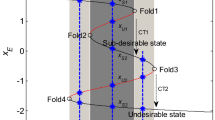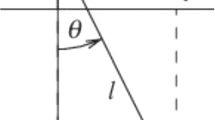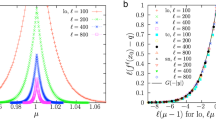Abstract
Many complex systems exhibit critical transitions. Of considerable interest are bifurcations, small smooth changes in underlying drivers that produce abrupt shifts in system state. Before reaching the bifurcation point, the system gradually loses stability (‘critical slowing down’). Signals of critical slowing down may be detected through measurement of summary statistics, but how extrinsic and intrinsic noises influence statistical patterns prior to a transition is unclear. Here, we consider a range of stochastic models that exhibit transcritical, saddle-node and pitchfork bifurcations. Noise was assumed to be either intrinsic or extrinsic. We derived expressions for the stationary variance, autocorrelation and power spectrum for all cases. Trends in summary statistics signaling the approach of each bifurcation depend on the form of noise. For example, models with intrinsic stochasticity may predict an increase in or a decline in variance as the bifurcation parameter changes, whereas models with extrinsic noise applied additively predict an increase in variance. The ability to classify trends of summary statistics for a broad class of models enhances our understanding of how critical slowing down manifests in complex systems approaching a transition.



Similar content being viewed by others
References
Allen EJ (2007) Modeling with Itô stochastic differential equations. Springer, Dordrecht
Allen LJS (2003) An introduction to stochastic processes with applications to biology. Prentice Hall, Upper Saddle River
Arnold L (1998) Random dynamical systems. Springer, Berlin
Bauch CT, Sigdel R, Pharaon J, Anand M (2016) Early warning signals of regime shifts in coupled human–environment systems. Proc Natl Acad Sci USA 113(51):14560–14567
Boerlijst MC, Oudman T, de Roos AM (2013) Catastrophic collapse can occur without early warning: examples of silent catastrophes in structured ecological models. PLoS ONE 8(4):e62033. https://doi.org/10.1371/journal.pone.0062033
Boettiger C, Hastings A (2012) Quantifying limits to detection of early warning for critical transitions. J R Soc Interface 9(75):2527–2539. https://doi.org/10.1098/rsif.2012.0125
Brett TS, Drake JM, Rohani P (2017) Anticipating the emergence of infectious diseases. J R Soc Interface 14(132):20170115
Carpenter SR, Brock WA (2006) Rising variance: a leading indicator of ecological transition. Ecol Lett 9(3):311–318
Carpenter SR, Ludwig D, Brock WA (1999) Management of eutrophication for lakes subject to potentially irreversible change. Ecol Appl 9(3):751. https://doi.org/10.2307/2641327
Dai L, Korolev KS, Gore J (2013) Slower recovery in space before collapse of connected populations. Nature 496(7445):355–8. https://doi.org/10.1038/nature12071
Dakos V, van Nes EH, D’Odorico P, Scheffer M (2012a) Robustness of variance and autocorrelation as indicators of critical slowing down. Ecology 93:264–271
Dakos V, Carpenter SR, Brock WA, Ellison AM, Guttal V, Ives AR, Kefi S, Livina V, Seekell DA, van Nes EH, Scheffer M (2012b) Methods for detecting early warnings of critical transitions in time series illustrated using simulated ecological data. PLoS One 7:e41010. https://doi.org/10.1371/journal.pone.0041010
Dakos V, van Nes EH, Scheffer M (2013) Flickering as an early warning signal. Theor Ecol 6(3):309–317. https://doi.org/10.1007/s12080-013-0186-4
Ditlevsen PD, Johnsen SJ (2010) Tipping points: early warning and wishful thinking. Geophys Res Lett. https://doi.org/10.1029/2010GL044486
Drake JM, Hay SI (2017) Monitoring the path to the elimination of infectious diseases. Trop Med Infect Dis 2(3):20
Fenichel N (1979) Geometric singular perturbation theory for ordinary differential equations. J Differ Equ 31:53–98
Gardiner CW (2004) Handbook of stochastic methods for physics, chemistry and the natural sciences. Springer, Berlin
Gillespie DT (2009) Deterministic limit of stochastic chemical kinetics. J Phys Chem B 113(6):1640–4. https://doi.org/10.1021/jp806431b
Guckenheimer J, Holmes P (1983) Nonlinear oscillations, dynamical systems, and bifurcations of vector fields, applied mathematical sciences, vol 42. Springer, New York
Han BA, Drake JM (2016) Future directions in analytics for infectious disease intelligence. EMBO Rep 17(6):785–789
Holling CS (1996) Engineering resilience versus ecological resilience. In: Schulze PC (ed) Engineering within ecological constraints. National Academy of Sciences, Washington, pp 31–44. https://doi.org/10.17226/4919. arXiv:1011.1669v3
Ives AR, Dakos V (2012) Detecting dynamical changes in nonlinear time series using locally linear state-space models. Ecosphere. https://doi.org/10.1890/ES11-00347.1
Ives AR, Dennis B, Cottingham KL, Carpenter SR (2003) Estimating community stability and ecological interactions from time series data. Ecol Monogr 73(2):301–330. https://doi.org/10.1890/0012-9615(2003)073[0301:ECSAEI]2.0.CO;2
Karesh WB, Dobson A, Lloyd-Smith JO, Lubroth J, Ma D, Bennett M, Aldrich S, Harrington T, Formenty P, Loh EH, Machalaba CC, Thomas MJ, Heymann DL (2012) Ecology of zoonoses: natural and unnatural histories. Lancet 380(9857):1936–45
Keeling M, Grenfell B (1999) Stochastic dynamics and a power law for measles variability. Philos Trans R Soc B Biol Sci 354(1384):769–776. https://doi.org/10.1098/rstb.1999.0429
Keeling MJ (2000) Simple stochastic models and their power-law type behaviour. Theor Popul Biol 58(1):21–31. https://doi.org/10.1006/tpbi.2000.1475
Keeling MJ, Rohani P (2008) Modeling infectious diseases in humans and animals. Princeton University Press, Princeton
Kéfi S, Guttal V, Brock WA, Carpenter SR, Ellison AM, Livina VN, Seekell DA, Scheffer M, van Nes EH, Dakos V (2014) Early warning signals of ecological transitions: methods for spatial patterns. PloS ONE 9(3):e92097. https://doi.org/10.1371/journal.pone.0092097
Kuehn C (2011) A mathematical framework for critical transitions: bifurcations, fast-slow systems and stochastic dynamics. Physica D 240:1020–1035
Lade SJ, Gross T (2012) Early warning signals for critical transitions: a generalized modeling approach. PLoS Comput Biol 8(2):e1002360. https://doi.org/10.1371/journal.pcbi.1002360
Lenton TM (2011) Early warning of climate tipping points. Nat Clim Change 1:201–209
Lenton TM, Held H, Kriegler E, Hall JW, Lucht W, Rahmstorf S, Schellnhuber HJ (2008) Tipping elements in the Earth’s climate system. Proc Natl Acad Sci USA 105(6):1786–93
Lever JJ, van Nes EH, Scheffer M, Bascompte J (2014) The sudden collapse of pollinator communities. Ecol Lett 17(3):350–359
Ludwig D, Jones DD, Holling CS (1978) Qualitative analysis of insect outbreak systems: the spruce budworm and forest. J Anim Ecol 47(1):315–332. https://doi.org/10.2307/3939
Meiss JD (2007) Differential dynamical systems. Society for Industrial and Applied Mathematics, Philadelphia
Melbourne BA, Hastings A (2008) Extinction risk depends strongly on factors contributing to stochasticity. Nature 454(7200):100–103. https://doi.org/10.1038/nature06922
Nicolis C, Nicolis G (2014) Dynamical responses to time-dependent control parameters in the presence of noise: a normal form approach. Phys Rev E 89(2):022903. https://doi.org/10.1103/PhysRevE.89.022903
Nisbet RM, Gurney WSC (1982) Modelling fluctuating populations. Wiley, New York
O’Regan SM, Drake JM (2013) Theory of early warning signals of disease emergence and leading indicators of elimination. Theor Ecol 6(3):333–357. https://doi.org/10.1007/s12080-013-0185-5
O’Regan SM, Lillie JW, Drake JM (2016) Leading indicators of mosquito-borne disease elimination. Theor Ecol 9(3):269–286. https://doi.org/10.1007/s12080-015-0285-5
Pimm SL (1984) The complexity and stability of ecosystems. Nature 307:321–326. https://doi.org/10.1038/315635c0. arXiv:1011.1669v3
Quail T, Shrier A, Glass L (2015) Predicting the onset of period-doubling bifurcations in noisy cardiac systems. Proc Natl Acad Sci USA 112(30):9358–63. https://doi.org/10.1073/pnas.1424320112
Scheffer M (2009) Critical transitions in nature and society. Princeton University Press, Princeton
Scheffer M, Hosper SH, Meijer M-L, Moss B, Jeppesen E (1993) Alternative equilibria in shallow lakes. Trends Ecol Evolut 8(8):275–279
Scheffer M, Bascompte J, Brock WA, Brovkin V, Carpenter SR, Dakos V, Held H, van Nes EH, Rietkerk M, Sugihara G (2009) Early warning signals for critical transitions. Nature 461:53–59
Scheffer M, Carpenter SR, Lenton TM, Bascompte J, Brock W, Dakos V, van de Koppel J, van de Leemput IA, Levin SA, van Nes EH, Pascual M, Vandermeer J (2012) Anticipating critical transitions. Science 338:344–348
Sharma Y, Abbott KC, Dutta PS, Gupta AK (2014) Stochasticity and bistability in insect outbreak dynamics. Theor Ecol 8(2):163–174. https://doi.org/10.1007/s12080-014-0241-9
Strogatz SH (1994) Nonlinear dynamics and chaos with applications to physics, biology chemistry and engineering. Addison-Wesley, Reading
Trefois C, Antony PM, Goncalves J, Skupin A, Balling R (2015) Critical transitions in chronic disease: transferring concepts from ecology to systems medicine. Curr Opin Biotechnol 34:48–55. https://doi.org/10.1016/j.copbio.2014.11.020
van Nes EH, Scheffer M (2007) Slow recovery from perturbations as a generic indicator of a nearby catastrophic shift. Am Nat 169(6):738–747. https://doi.org/10.1086/516845
Veraart AJ, Faassen EJ, Dakos V, van Nes EH, Lürling M, Scheffer M (2012) Recovery rates reflect distance to a tipping point in a living system. Nature 481(7381):357–359. https://doi.org/10.1038/nature10723
Wang R, Ja D, Langdon PG, Zhang E, Yang X, Dakos V, Scheffer M (2012) Flickering gives early warning signals of a critical transition to a eutrophic lake state. Nature 492(7429):419–22. https://doi.org/10.1038/nature11655
Wissel C (1984) A universal law of the characteristic return time near thresholds. Oecologia 65(1):101–107. https://doi.org/10.1007/BF00384470
Acknowledgements
Much of this work was conducted while SMO was a Postdoctoral Fellow and DLB was a Graduate Research Assistant at the National Institute for Mathematical and Biological Synthesis, an Institute sponsored by the National Science Foundation through NSF Award # DBI-1300426, with additional support from The University of Tennessee, Knoxville. Additional support was obtained from North Carolina A&T State University. The authors would like to thank John Drake, Eamon O’Dea, Suzanne Lenhart and an anonymous reviewer for thoughtful comments on the manuscript.
Author information
Authors and Affiliations
Corresponding author
Appendix A: Variance Approaches Zero from the Right
Appendix A: Variance Approaches Zero from the Right
Since v(r) is always positive, by definition \(\lim \limits _{r\rightarrow 0^{+}}v(r) = 0\) if and only if for all \( \varepsilon > 0\) there exists some \(\delta >0\) so that \( \frac{g(x^s,r)^2}{2 | f'(x^s, r)|} < \varepsilon \) for each \( r\in (0,\delta )\). This can be restated as: \(\lim \limits _{r\rightarrow 0^{+}}v(r) = 0\) if and only if for all \(\varepsilon > 0\) there is \(\delta > 0\) so that for each \(r\in (0,\delta )\) we have
Consequently, if inequality (19) holds in some neighborhood of the bifurcation point for every \(\varepsilon > 0\), then the variance will approach 0 as r approaches the bifurcation point. Since we already have (10), inequality (19) implies that \(\lim \limits _{r\rightarrow 0^+}g(x^s,r)^2 = 0\) and that \(g(x^s,r)^2\) approaches 0 more rapidly than \(2|f'(x^s,r)|\). When (10) holds, both of these conditions on g are necessary conditions for \(\lim \limits _{r\rightarrow 0^{+}}v(r) = 0\), but inequality (19) is both necessary and sufficient. Comparing Fig. 2 with Table 6, we see that for models with intrinsic noise, the O–U variance curve declines to zero faster than the resilience term, and in each of these cases \(\lim \limits _{r\rightarrow 0^{+}}v(r) = 0\). The other case where \(\lim \limits _{r\rightarrow 0^{+}}v(r) = 0\) is with mechanistic environmental noise for the transcritical bifurcation case, where the O–U variance term also approaches zero more rapidly than the resilience term.
Rights and permissions
About this article
Cite this article
O’Regan, S.M., Burton, D.L. How Stochasticity Influences Leading Indicators of Critical Transitions. Bull Math Biol 80, 1630–1654 (2018). https://doi.org/10.1007/s11538-018-0429-z
Received:
Accepted:
Published:
Issue Date:
DOI: https://doi.org/10.1007/s11538-018-0429-z




